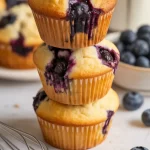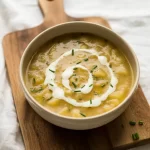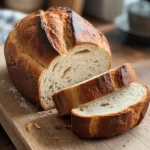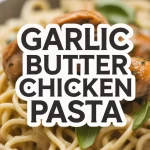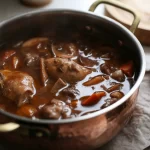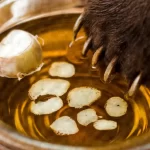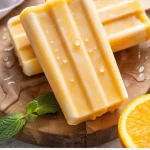As a professional recipe developer, I’m excited to share my puff pastry from scratch method, packed with step-by-step photos, video and insider tips that reveal the secrets behind perfectly flaky layers.

I’ve always been obsessed with the sound of layers crisping up, and this Classic Puff Pastry is the reason. When I fold cold unsalted butter into flour and watch those sheets come alive it’s like a little kitchen magic, messy and satisfying, not always perfect but always worth it.
I walk through every slow, patient turn in my Puff Pastry From Scratch approach so you can see where it goes wrong, and where it suddenly becomes amazing. If you like flaky, buttery surprises and don’t mind a bit of trial and error, stay with me, you’ll want to try this.
Why I Like this Recipe
– I love how it puffs into super flaky layers, the texture is insane when it’s fresh out the oven.
– It makes me look like I know what I’m doing, guests always act impressed even if I kind of winged it.
– It’s forgiving, i’ve messed it up before and still ended up with something tasty.
– I like that it’s flexible, I can turn it into a quick snack or something fancy and it never feels boring.
Ingredients

- All purpose flour: mainly carbs, some protein for gluten, gives structure and layered lift
- Unsalted butter: rich in fat, lots of flavor, creates flaky layers, not healthy in excess
- Fine salt: no calories, enhances flavor, helps gluten and balances sweetness
- Ice cold water: hydrates dough, controls temperature for flaky lamination, simple and neutral
- Granulated sugar: adds slight sweetness, aids browning and tenderizes, use sparingly
- White vinegar or lemon juice: small acid helps relax gluten and improve tenderness
- Large egg: protein rich, optional for egg wash to give golden shine and brown color
Ingredient Quantities
- All purpose flour 500 g (about 4 cups)
- Unsalted butter 375 g (about 1 2/3 cups), very cold, preferably European style for better flavor
- Fine salt 10 g (about 2 teaspoons)
- Ice cold water 250 ml to 300 ml (about 1 to 1 1/4 cups)
- Granulated sugar 1 tablespoon optional
- White vinegar or lemon juice 1 teaspoon optional
- Large egg 1 beaten, optional for egg wash
How to Make this
1. Mix the dry stuff: put 500 g all purpose flour, 10 g fine salt and 1 tablespoon sugar if you want a touch of sweetness into a bowl, stir to combine.
2. Make the dough base (detrempe): whisk 1 teaspoon vinegar or lemon into about 250 ml ice cold water, then add the water slowly to the flour while stirring with a fork until you have a shaggy, slightly sticky dough that just holds together; use 250 ml first and add up to 50 ml more only if needed. Shape into a rough rectangle, wrap and chill 30 minutes.
3. Make the butter block: take 375 g very cold unsalted butter (European style is best), grate or cut into cubes and press between two sheets of parchment with a rolling pin until you have a neat square about 1 cm thick and a little smaller than the dough center; keep it cold but still pliable, put back in the fridge if it softens.
4. Encase the butter: roll chilled dough into a rectangle big enough to wrap the butter, put the butter block in the middle, fold the dough over the butter and seal the edges so the butter is fully enclosed, turn the seam side down.
5. First roll and fold: lightly flour your board and roll the parcel into a long rectangle about three times as long as it is wide, try to keep edges straight and even; fold into thirds like a business letter, that is one single turn. Wrap and chill 30 minutes.
6. Repeat turns: do five more single turns for a total of six turns, rolling out and folding into thirds each time; keep the surface and dough lightly floured, work quickly so the butter stays cold, and if butter starts to ooze or dough gets sticky chill for 15 to 30 minutes before continuing.
7. Rest and chill: after the final turn chill the dough at least 1 hour or overnight, this relaxes the gluten and firms the butter so the layers bake up well.
8. Use or shape: roll the chilled pastry to the thickness your recipe calls for, cut into shapes for tarts, turnovers or millefeuille, repair any small tears by pinching or patching with a bit of scraps.
9. Egg wash and bake plus storage: if you want a glossy finish beat 1 large egg with a splash of water and brush lightly before baking; bake shapes in a very hot oven 200 to 220 C (400 to 425 F) until puffed and golden, 12 to 25 minutes depending on size. Dough freezes well between turns or after the final chill, thaw in the fridge before rolling.
Equipment Needed
1. Digital kitchen scale, for weighing flour and butter accurately
2. Large mixing bowl, to mix the dry stuff and make the detrempe
3. Whisk and fork, whisk for the vinegar in the water, fork to stir the shaggy dough
4. Box grater or sharp knife and cutting board, to grate or cube very cold butter
5. Rolling pin, to press the butter into a neat block and to roll the pastry out
6. Parchment paper, for pressing the butter block and wrapping the parcel
7. Bench scraper, great for turning trimming and repairing pastry pieces
8. Plastic wrap, to wrap dough between turns and keep it from drying out
9. Pastry brush, rimmed baking sheet, refrigerator and oven, for egg wash chilling and baking
FAQ
Classic Puff Pastry Recipe Substitutions and Variations
- All purpose flour → Pastry flour, 1:1 by weight. Gives a more tender, delicate crumb. If you only have bread flour, you can use it 1:1 but the pastry will be chewier and needs gentler handling and more chill time.
- Unsalted butter 375 g → Salted butter: use same weight but cut the added fine salt from 10 g to about 5 g. Or for extra flake and easier rolling try 50/50 unsalted butter and vegetable shortening by weight, flavor will be a bit less rich.
- Ice cold water 250–300 ml → Replace up to half the water with ice cold vodka (same total volume) to limit gluten formation and make rolling easier; or swap water for ice cold whole milk for a richer, slightly softer dough.
- Large egg (egg wash) → Use whole milk or heavy cream brushed on for a light golden finish, or just egg white for extra shine and deeper brown. For an egg-free option try aquafaba or a non dairy milk mixed with a little syrup.
Pro Tips
1) Keep everything cold but not frozen. Chill the dough between turns and if the butter starts to weep or get greasy, pop the whole parcel in the fridge or freezer for 10 to 15 minutes. Working too warm is the fastest way to lose your layers.
2) Make the butter block neat and even. Press it to a uniform thickness and a little smaller than the dough center so it stays encased, and score very light guide lines on the butter with a knife so you can line up edges when rolling.
3) Roll with gentle, even pressure and use flour sparingly. Too much flour makes the pastry dry and tough, and uneven rolling makes ragged layers. Turn the dough as you roll to keep edges straight, and use a bench scraper to help lift instead of tugging.
4) Rest is not optional. Let the dough relax after the first couple turns and especially after the final turn, chilling at least an hour or overnight if you can. Resting firms the butter and lets gluten relax so the layers puff cleanly.
5) Bake hot and finish smart. Brush egg wash lightly only where you want shine, vent any filled shapes so steam can escape, and add a quick blast of steam in the first few minutes of baking if you want extra lift. If you need to pause, freeze between turns or after the final chill and thaw in the fridge before rolling.

Classic Puff Pastry Recipe
As a professional recipe developer, I'm excited to share my puff pastry from scratch method, packed with step-by-step photos, video and insider tips that reveal the secrets behind perfectly flaky layers.
8
servings
579
kcal
Equipment: 1. Digital kitchen scale, for weighing flour and butter accurately
2. Large mixing bowl, to mix the dry stuff and make the detrempe
3. Whisk and fork, whisk for the vinegar in the water, fork to stir the shaggy dough
4. Box grater or sharp knife and cutting board, to grate or cube very cold butter
5. Rolling pin, to press the butter into a neat block and to roll the pastry out
6. Parchment paper, for pressing the butter block and wrapping the parcel
7. Bench scraper, great for turning trimming and repairing pastry pieces
8. Plastic wrap, to wrap dough between turns and keep it from drying out
9. Pastry brush, rimmed baking sheet, refrigerator and oven, for egg wash chilling and baking
Ingredients
-
All purpose flour 500 g (about 4 cups)
-
Unsalted butter 375 g (about 1 2/3 cups), very cold, preferably European style for better flavor
-
Fine salt 10 g (about 2 teaspoons)
-
Ice cold water 250 ml to 300 ml (about 1 to 1 1/4 cups)
-
Granulated sugar 1 tablespoon optional
-
White vinegar or lemon juice 1 teaspoon optional
-
Large egg 1 beaten, optional for egg wash
Directions
- Mix the dry stuff: put 500 g all purpose flour, 10 g fine salt and 1 tablespoon sugar if you want a touch of sweetness into a bowl, stir to combine.
- Make the dough base (detrempe): whisk 1 teaspoon vinegar or lemon into about 250 ml ice cold water, then add the water slowly to the flour while stirring with a fork until you have a shaggy, slightly sticky dough that just holds together; use 250 ml first and add up to 50 ml more only if needed. Shape into a rough rectangle, wrap and chill 30 minutes.
- Make the butter block: take 375 g very cold unsalted butter (European style is best), grate or cut into cubes and press between two sheets of parchment with a rolling pin until you have a neat square about 1 cm thick and a little smaller than the dough center; keep it cold but still pliable, put back in the fridge if it softens.
- Encase the butter: roll chilled dough into a rectangle big enough to wrap the butter, put the butter block in the middle, fold the dough over the butter and seal the edges so the butter is fully enclosed, turn the seam side down.
- First roll and fold: lightly flour your board and roll the parcel into a long rectangle about three times as long as it is wide, try to keep edges straight and even; fold into thirds like a business letter, that is one single turn. Wrap and chill 30 minutes.
- Repeat turns: do five more single turns for a total of six turns, rolling out and folding into thirds each time; keep the surface and dough lightly floured, work quickly so the butter stays cold, and if butter starts to ooze or dough gets sticky chill for 15 to 30 minutes before continuing.
- Rest and chill: after the final turn chill the dough at least 1 hour or overnight, this relaxes the gluten and firms the butter so the layers bake up well.
- Use or shape: roll the chilled pastry to the thickness your recipe calls for, cut into shapes for tarts, turnovers or millefeuille, repair any small tears by pinching or patching with a bit of scraps.
- Egg wash and bake plus storage: if you want a glossy finish beat 1 large egg with a splash of water and brush lightly before baking; bake shapes in a very hot oven 200 to 220 C (400 to 425 F) until puffed and golden, 12 to 25 minutes depending on size. Dough freezes well between turns or after the final chill, thaw in the fridge before rolling.
Notes
- Below you’ll find my best estimate of this recipe’s nutrition facts. Treat the numbers as a guide rather than a rule—great food should nourish both body and spirit. Figures are approximate, and the website owner assumes no liability for any inaccuracies in this recipe.
Nutrition Facts
- Serving Size: 144g
- Total number of serves: 8
- Calories: 579kcal
- Fat: 39.2g
- Saturated Fat: 24.1g
- Trans Fat: 0.52g
- Polyunsaturated: 1.49g
- Monounsaturated: 10.1g
- Cholesterol: 124mg
- Sodium: 502mg
- Potassium: 86mg
- Carbohydrates: 49.1g
- Fiber: 1.69g
- Sugar: 1.8g
- Protein: 7.38g
- Vitamin A: 386IU
- Vitamin C: 0mg
- Calcium: 24mg
- Iron: 0.91mg


